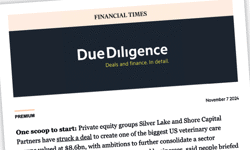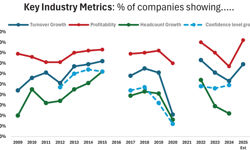Will Lewis, chief executive of Dow Jones, reaches for Dickens to help explain what is going on in the US newspaper industry at the moment.
“It is both the best of times and the worst of times,” says the award-winning former editor-in-chief of the Daily Telegraph.
It is, he believes, the best of times for Dow Jones and the Wall Street Journal and the worst of times for general newspapers heavily dependent on advertising.
The best of times
“We are doing very well both commercially and in our journalism. Print is stable, digital subscriptions will soon reach one million and mobile is the bit we are getting most excited about, plus using data to drive cross-platform deals,” explains Lewis who also used to work for the Financial Times.
The FT is known for its close relationship with the UK’s business and financial community, but Lewis insists he has never seen anything like the Wall Street Journal’s position in American society.
“It is hard to overstate how much the Wall Street Journal is woven into the political, economic and cultural fabric of the US. It’s a unique readership group as well. I have yet to meet a US business person that doesn’t have the Journal either in newspaper or iPad form, or increasingly through its mobile offering,” says Lewis.
From time to time, he summons executives to the glass box where he holds meetings at Dow Jones’ New York headquarters to ask whether he is missing something fundamental, amid fears that the Wall Street Journal newspaper could be engulfed by the march of the internet and the loss of advertising to online like many other publications. So far, it hasn’t happened.
As things stand, the print editions of the Wall Street Journal total 1.447 million copies including hotel distribution, while the individual digital subscriptions come in at 828,000.
“It does come back to that customer group. The advertising proposition is a very straightforward one. If you want to reach the most important people in finance, in politics and increasingly in technology – we have a big footprint on the West coast as well- then the only place you can do that is in the Wall Street Journal,” says the naturally exuberant 47-year-old Lewis.
The Dow Jones chief executive says the desirability of its audience means that the company can hold its rate card and continue to fund serious investigative journalism, although advertising accounts for only 40 per cent of total revenue.
Lewis, who led the 50-strong team at the Daily Telegraph who exposed the MPs expenses scandal and won both the journalist of the year and newspaper of the year award in 2010, promises there will be no dumbing down at the Journal.
“No cats on skateboard videos or ten reasons why Donald Trump’s hair might be real,” goes his mantra.
He is proud of the Journal’s investigative reporting on a $9 billion Silicon Valley start-up, Theranos, raising serious questions about the company’s trademark ability to carry out 240 different medical tests from drops of blood.
“We have also done brilliant investigative work into alleged corruption at the heart of the Malaysian government,” says Lewis.
The worst of times
It is the worst of times for general newspapers in the US, more reliant than the Journal on advertising, and Lewis is desperate to emphasise the Wall Street Journal is not the same “as these other newspapers in a death spiral”.
This will be a decisive year for American newspapers and on the day he was talking, it was announced that a further round of consolidation could be under way as Gannett made an $815 million bid for the Tribune Group, publishers of the Los Angeles Times.
Lewis fears there may not be many newspaper competitors around in future “unless they change their strategies pretty quickly”. They simply cannot continue to rely so much on the fickle advertising world for survival, he believes.
“Our biggest challenge is not getting dragged into this morass of depression about the print industry. Every day brings news – of the ‘my God this is terrible’ variety - and it’s not terrible for us, print remains a very strong platform amongst many for us,” insists Lewis.
“My main worry is that we seem to be the only people out there still talking about the power of print because it is a vital part of our mix but we really need other people to recognise that. The engagement stats are mindboggling. People are really reading this stuff,” Lewis emphasises.
He accepts, however, if he were in print alone, it would be quite a lonely place to be and accepts that there is no magic script pointing a way to the future. Rather, it’s a case of continually making small improvements and finding new ways of reaching customers and creating additional revenue streams.
All the rage
Many of the small improvements come from what Lewis calls his “rage weeks” – identifying a particular weakness and personally raging about it until something is done.
One of his recent rages was directed at the complexity of the process for signing up mobile subscribers, a system that took fourteen steps and was losing many potential subscribers in the process.
“I don’t know why you want my inside leg measurements … forget it. Four people fixed it in three weeks and we now have a state of the art mobile subscription offering. Now it takes only seven steps and no longer than a minute to subscribe to the Wall Street Journal,” Lewis explains.
Another was directed at speeding up the online offerings of Dow Jones.
Lewis is determined to provide flexible offerings if that is what the customer wants.
“We have to respond to difficult customers asks – like customers who only want to read the paper on Fridays and Saturdays, that’s our problem not their problem,” Lewis explains.
The changing world of advertising
The nature of advertising too has changed dramatically and become more bespoke. Once selling involved little more than saying whether a 25 by 4 slot was available, now it’s about reaching the Journal audience on a variety of platforms and even includes deals with online television operators such as Netflix.
The Wall Street Journal’s custom studios produced native advertising material to be associated with the launch of Narcos, Netflix’s bilingual story of the Colombian cocaine boss Pablo Escobar.
The Journal created new content, including video interviews with drug enforcement agents and an interactive map devoted to the story of cocaine as an international business. Different promotional material was produced for different age groups. The fee is not disclosed but is understood to be large and a template for future development.
Live events are also becoming more important financially for the Journal with twelve main conferences a year including two major ones, the CEO Council in Washington DC, and a technology conference held in Laguna Beach, California.
“The conferences are really effective ways, allied to other advertising on other platforms, for advertisers to get their message across,” notes Lewis.
Member benefits
Then there is the WSJ+ club which now has more than 400,000 members who get benefits such as free ebooks from HarperCollins, like Dow Jones, part of the Murdoch empire.
The aim is to turn as many subscribers into club members as possible and there are a total of 2.4 million subscribers across Dow Jones which includes business to business operations, desktop financial news services and Barron’s business magazine. The internal target is to lift the total number of subscribers to 3 million.
Overall, Dow Jones produces 8,000 pieces of content a day and Lewis believes that to make that content more valuable, the company has to stop thinking in silos.
“You are not just writing for the Wall Street Journal. If we tailor and collate it for a geographic audience, we are on to something,” muses Lewis.
Despite its long history, Lewis believes there is still room for the Wall Street Journal newspaper to expand in many parts of the US, but the real goal is to try to get new readers to subscribe to the paper and at least one digital product. The evidence shows the combination increases loyalty and reduces churn.
International growth
The biggest Wall Street Journal expansion is expected outside the US through the targeting of sixteen cities worldwide where the largest clusters of potential Journal readers are to be found. One of those key cities is obviously London.
The European edition was re-launched last September to make it look more like the US edition and Lewis says he is really proud of it and there is also an iPad app for the European edition.
In the hope of reaching a younger audience, the company has launched a WSJ City app in London with bite sized chunks of information, unashamedly branded in pink, which also contains some editorial from The Times of London.
“It’s early days, but it’s quite popular and you can drive through to longer form content as well if you want to read the full piece,” says Lewis.
He is considering using the same template to launch a mobile service in India.
If Will Lewis’s greatest journalistic achievement was in London at the Daily Telegraph, the greatest controversy he has faced also happened in London following the News of the World phone-hacking scandal.
Lewis led the team at News UK, which handed over records of journalists and sources to police, which led to prosecutions and jail sentences, particularly for newspaper sources.
Lewis has been accused of breaching the journalistic principle that sources should never be revealed.
The Dow Jones executive says he is unable to comment until all prosecutions and appeals have gone through the legal system.
Where does he think Dow Jones and the Wall Street Journal will be in five years?
“I think we will be in bloody good shape with a much larger subscription base. We will have made the shift to being truly global – the international strategy will have paid off brilliantly.
It will be a multi-platform operation with print still at the heart of its DNA but in a fully digital company,” predicts Will Lewis who will have had quite a few more rage weeks by then.












